Ginger tea has captivated taste buds and health enthusiasts around the world. This aromatic beverage offers a delightful combination of spicy warmth and soothing qualities. Moreover, ginger boasts a plethora of health benefits that make it a staple in kitchens and wellness practices. This article provides a detailed ginger tea recipe, explores its health benefits, and shares valuable tips and variations to create the perfect cup every time.
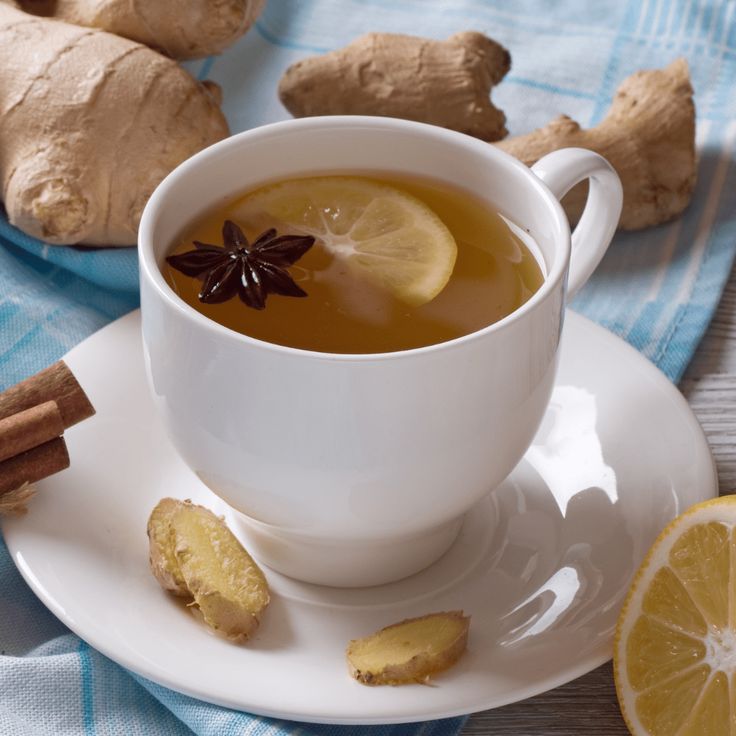
Benefits of Ginger Tea
Ginger tea is a simple yet powerful drink enjoyed for centuries. It is famed for its healing properties and soothing flavor. Whether you’re looking for health benefits or warm comfort, ginger tea delivers with every cup.
Health Benefits of Ginger
Ginger is packed with antioxidants that promote overall well-being. It aids digestion and reduces bloating effectively. Ginger can also help with nausea, especially during pregnancy or travel. It boasts anti-inflammatory properties, making it great for joint health. Regular ginger consumption may improve immune function and fight off colds. Additionally, ginger may lower blood sugar levels and reduce the risk of heart disease.
Why Ginger Tea is a Popular Choice
The natural spiciness of ginger tea is both warming and soothing. It is easy to prepare and adapt to taste preferences. Many drink ginger tea to unwind after a stressful day. Its versatility allows you to mix it with lemon, honey, or spices for variety. Ginger tea is also caffeine-free, making it suitable for all times of the day. Overall, its health benefits and delicious flavor make it a popular choice worldwide.
Ingredients Needed for Ginger Tea
To make a soothing cup of ginger tea, you’ll need only a few simple ingredients. The basics include ginger and water. However, you can customize it with optional add-ins for more flavor and variety.
Fresh Ginger vs. Ginger Powder
The type of ginger you choose impacts the flavor and aroma of your tea. Fresh ginger is often preferred for its natural, zesty taste and vibrant fragrance. It is also easy to slice or grate for immediate use. Choose firm, smooth-skinned ginger root for the best results.
Ginger powder is a convenient alternative when fresh ginger isn’t available. It provides a slightly milder and less fresh taste. However, powdered ginger is still rich in flavor and works well in quick recipes. Keep in mind that its potency differs, so you may need to adjust the quantity.
Water
Water serves as the base for brewing ginger tea. Choose filtered or purified water for the best taste. The quality of your water can significantly affect the overall flavor of the tea, so select a source that you enjoy drinking.
Sweetener (Optional)
While ginger tea has a naturally spicy flavor, many people enjoy adding a sweetener. Options include honey, agave nectar, stevia, or even brown sugar. Each sweetener contributes a unique flavor profile, allowing you to customize your tea to your liking.
Lemon or Lime (Optional)
Adding lemon or lime juice elevates the flavor and adds nutritional benefits. The vibrant citrus taste complements the spiciness of ginger while introducing vitamin C.
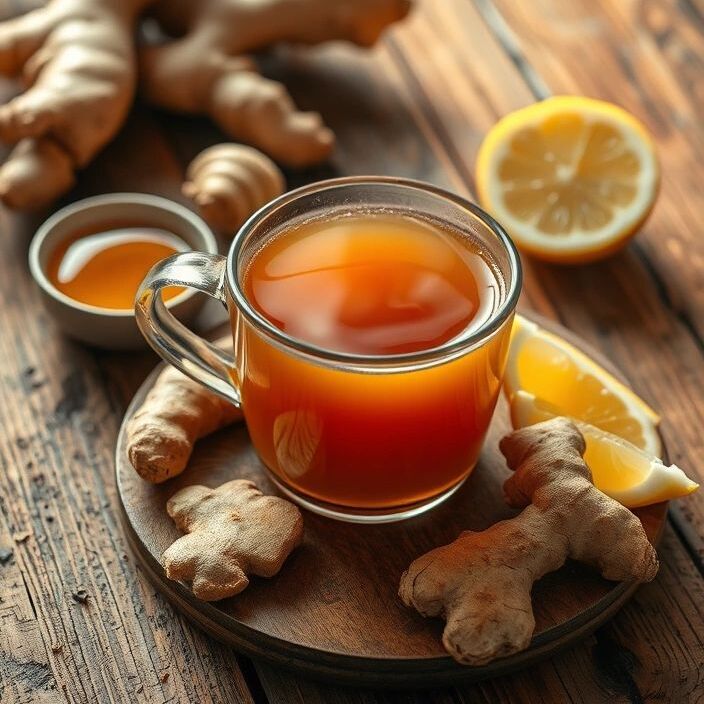
Step-by-Step Guide to Making Ginger Tea
Making ginger tea is straightforward and rewarding. Follow these steps for a perfectly brewed cup.
Preparing Fresh Ginger
- Choose Fresh Ginger: Select firm, smooth ginger roots for the best taste and aroma.
- Wash Thoroughly: Rinse the ginger under water to remove dirt and impurities.
- Peel the Skin: Use a spoon or knife to peel the skin gently.
- Slice or Grate: Thinly slice or grate the ginger for maximum flavor extraction.
Fresh ginger is ideal for making bold and aromatic tea. Use about 1-2 tablespoons per cup.
Boiling and Brewing Techniques
- Add Ginger to Water: Place the prepared ginger in a small pot.
- Boil the Water: Add 1-2 cups of water for every 1-2 tablespoons of ginger.
- Simmer: Bring the water to a boil, then reduce to a simmer for 10-15 minutes.
- Strain: Pour the tea through a fine strainer to remove ginger pieces.
- Serve: Pour into a cup and enjoy it hot.
For stronger flavor, extend the simmering time. For a lighter taste, shorten the cooking duration.
These easy preparation steps will ensure your ginger tea recipe becomes a go-to staple.
Customizing Your Ginger Tea
Ginger tea is a wonderful beverage that you can easily adapt to fit your taste preferences. With just a few simple tweaks, you can change its strength, sweetness, or even add unique flavors. These adjustments ensure that every cup feels personalized and perfect just for you.
Adjusting Strength and Flavor
- Use More Ginger for Intensity: Add extra slices or grated ginger for a bold, spicy flavor.
- Simmer Longer for Richness: Extend the boiling time for a stronger and deeper essence.
- Dilute for Mildness: Add more water if you prefer a gentler, lighter taste.
- Try Fresh vs Powdered Ginger: Experimenting with both fresh and powdered ginger allows you to discover what suits your flavor preference best. Fresh ginger offers a bright and zesty kick, while powdered ginger provides a more subdued, earthy flavor.
Balancing the strength of ginger tea is simple. Adjust the quantity of ginger and the brewing time to suit your liking.
Adding Sweeteners or Citrus
- Honey: One of the most popular sweeteners, honey adds natural sweetness along with soothing properties that can calm sore throats.
- Sugar or Stevia: If you want to achieve extra sweetness quickly, sugar or stevia can be excellent choices. They dissolve easily, making them great for instant gratification.
- Lemon Juice: For a delightful citrus twist and vibrant flavor, squeeze fresh lemon into your ginger tea. The acidity perfectly balances the ginger’s warmth.
- Orange Slices: Adding orange slices introduces a fruitier, sweet-tangy touch. This combination enhances the tea’s flavor and adds a refreshing element.
Sweeteners and citrus options elevate your ginger tea’s flavor profile. Feel free to experiment with different combinations to create your ideal cup. With these simple adjustments, your ginger tea can become a drink you look forward to every day.
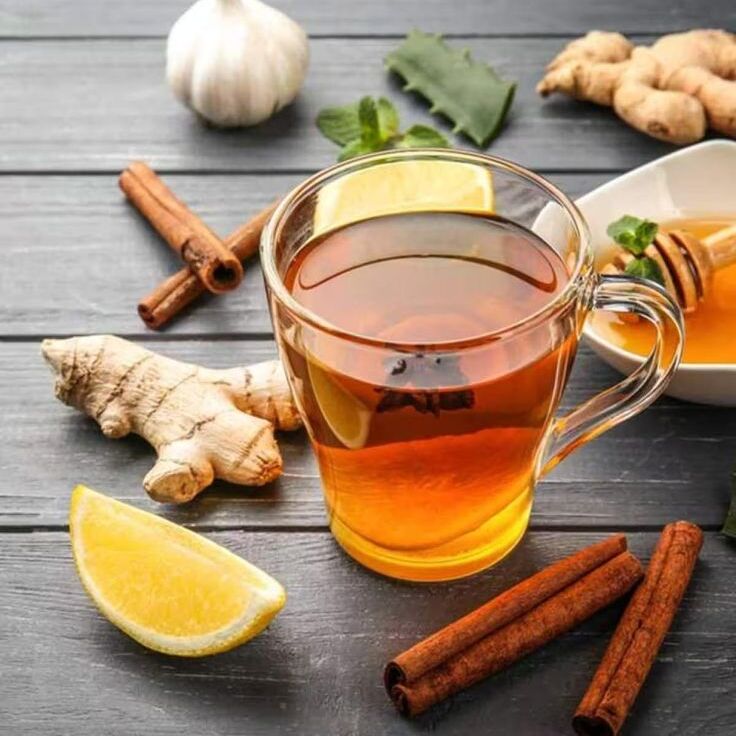
Creative Ginger Tea Variations
Ginger tea is a versatile beverage that can be customized in countless ways to create new and exciting flavors. Here are a couple of popular variations that you can try at home, each offering unique taste profiles and delightful health benefits.
Ginger Lemon Tea Recipe
Ginger lemon tea combines the spiciness of fresh ginger with the tanginess of lemon. This refreshing drink is not only delicious but also packed with antioxidants and vitamin C. To prepare this invigorating tea, follow these steps:
- Prepare Ginger: Start by thinly slicing or grating 1 to 2 tablespoons of fresh ginger. The amount can be adjusted based on your spice preference.
- Boil with Water: Add the ginger to 1 to 2 cups of water in a saucepan. Bring the mixture to a boil and allow it to simmer for about 10 minutes. This duration helps extract the full flavor from the ginger.
- Add Lemon Juice: After boiling, remove the pot from heat and squeeze the juice of half a lemon into the tea. Adjust the amount of lemon juice according to your desired tartness.
- Sweeten If Desired: If you prefer a sweeter beverage, stir in honey or sugar to taste.
- Serve: Strain the tea into a cup and enjoy your hot, zesty concoction. This light and rejuvenating tea is perfect for mornings or whenever you feel run down.
This light and rejuvenating tea is perfect for mornings or when you feel run down.
Spiced Ginger Tea with Cinnamon and Cloves
For a warming and aromatic drink, try spiced ginger tea infused with cinnamon and cloves. This cozy beverage is perfect for chilly days. Here’s how to prepare it:
- Prepare Ginger and Spices: Slice 1 to 2 tablespoons of fresh ginger. Add a cinnamon stick and 2 to 3 whole cloves to the mix for added warmth and flavor.
- Boil Together: Combine the ginger, cinnamon, and cloves in 2 cups of water in a saucepan. Bring to a simmer and let it cook for about 15 minutes, allowing the spices to release their rich aromas.
- Sweeten: Once simmered, add honey or brown sugar for a hint of sweetness. Adjust the sweetness to your liking.
- Strain and Serve: Remove the spices by straining the tea into a mug. Serve the tea hot and enjoy its bold flavors, which create a comforting experience.
This rich tea is ideal for relaxing evenings or fighting off a cold. Both variations add exciting twists to the classic ginger tea recipe, making them must-try options for tea lovers.
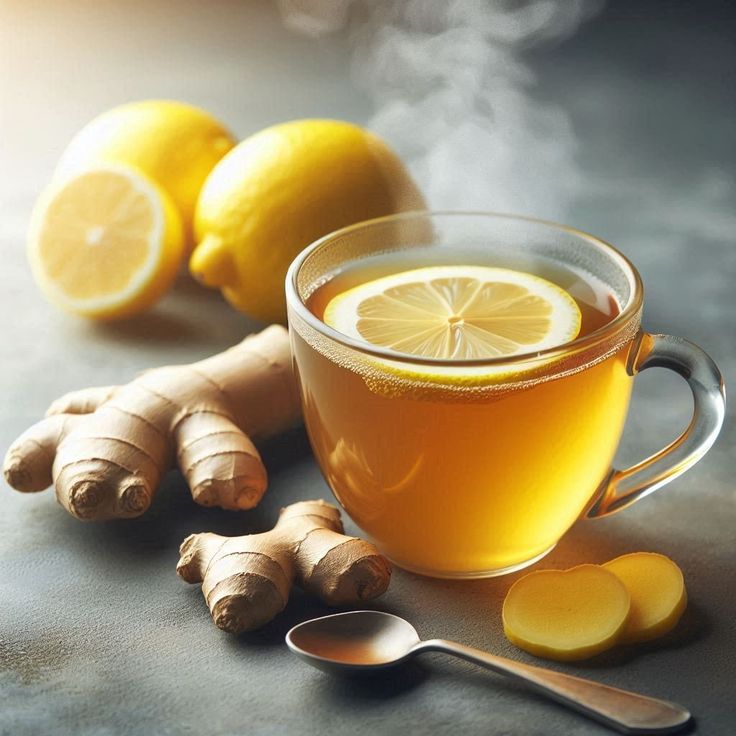
Storing and Reheating Ginger Tea
Proper storage and reheating methods are essential for maintaining the freshness and flavor of your ginger tea recipe. Follow these tips to enjoy a great cup anytime.
Best Practices for Freshness
- Use an Airtight Container: Store any leftover ginger tea in a clean, airtight container. This prevents air exposure, which can lead to flavor loss and spoilage.
- Refrigerate Immediately: Place the container in the refrigerator within two hours of brewing. Quick refrigeration helps retain both quality and taste.
- Avoid Keeping Too Long: Consume stored tea within 2-3 days for the best taste and safety. Beyond this timeframe, the flavor may diminish, and there might be a risk of spoilage.
- Label with Date: Mark the storage date on the container. This simple practice helps you track freshness and ensures you enjoy the tea at its best.
- Keep Add-Ins Separate: Avoid adding lemon, honey, or spices into the tea before storing. Add these ingredients only when serving to prevent unwanted flavor changes during storage.
Tips for Reheating Brewed Tea
When it comes to reheating brewed ginger tea, following a few simple tips will help retain its delightful flavor and aroma. Here are some effective strategies to ensure your tea remains enjoyable.
- Use a Low Heat: Begin by reheating your ginger tea on low heat in a saucepan. This gentle approach allows for even warming, preventing hot spots that can occur with higher temperatures.
- Avoid Boiling Again: It’s important not to bring the tea to a boil again. Boiling can alter its taste and diminish the aromatic qualities that make ginger tea so appealing. Keep the heat low to maintain the essence of the tea.
- Microwave Option: If you choose to use the microwave, heat your tea in short intervals of about 30 seconds. Stir the tea between each interval to distribute heat evenly and prevent overheating.
- Add Fresh Flavors: Consider refreshing your reheated tea with a splash of fresh lemon juice or a drizzle of honey. These additions enhance the taste and introduce a delightful burst of flavor.
- Strain Before Reheating: If you have spices or pieces of ginger in your tea, strain them out before reheating. This step helps to maintain a smooth texture, making for a more enjoyable drinking experience.
Proper storage and careful reheating will ensure your ginger tea remains as delicious as when freshly brewed, allowing you to savor every sip.
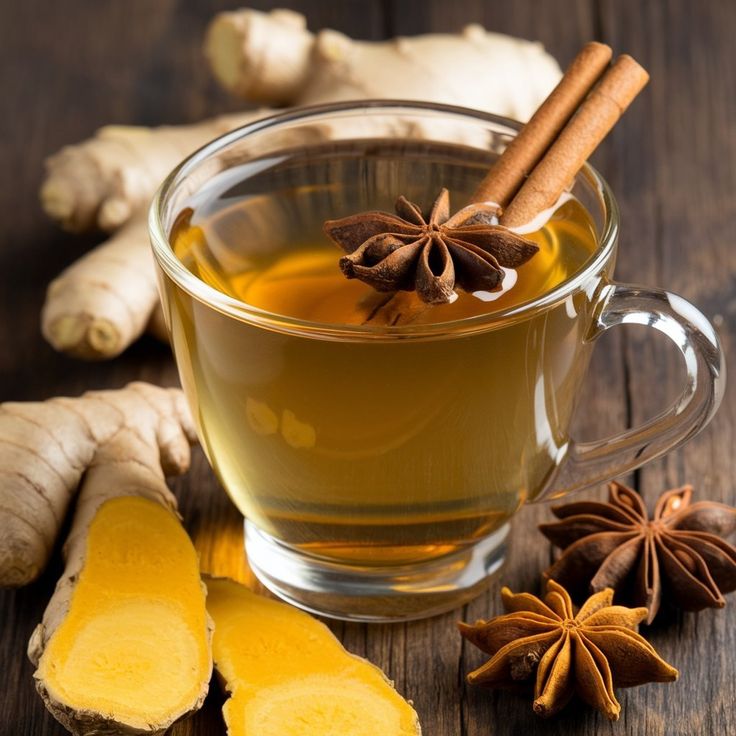
Frequently Asked Questions About Ginger Tea
How Long to Steep Ginger for Optimal Flavor
Steeping time plays a key role in achieving the perfect ginger tea flavor. The ideal duration is between 10-15 minutes. This allows the ginger’s natural oils and flavors to infuse effectively. For a bolder taste, extend the simmering time up to 20 minutes. If you prefer a lighter flavor, reduce the steeping time to 5-7 minutes. Always taste the tea during the simmering process to ensure it matches your preference.
The size and cut of the ginger also influence brewing. Thin slices or grated ginger release flavor faster. Larger chunks may require extra time for a robust taste. Be mindful as over-steeping can lead to a bitter aftertaste.
Can Ginger Tea Be Made Ahead of Time?
Yes, ginger tea can be made ahead and stored for later use. To retain freshness, refrigerate it immediately after brewing. Use an airtight container to prevent unwanted flavors from seeping in. Prepared ginger tea can last up to 2-3 days when stored properly. Mark the container with the brewing date to track its freshness.
Avoid adding sweeteners or citrus until serving. This prevents flavor changes during storage. When ready to enjoy, reheat gently using low heat on the stove or in the microwave. Never re-boil the tea, as it may diminish its flavor and aroma.
Storing ginger tea recipe allows you to enjoy its benefits conveniently. Whether reheating or adding a twist, pre-made ginger tea is a versatile option for busy days.